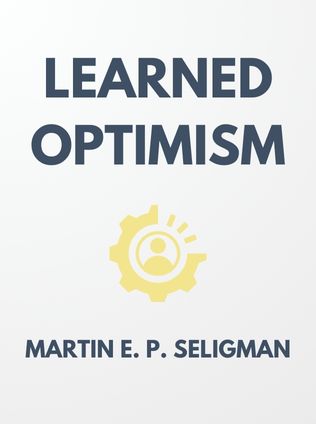
Learned Optimism
How to Change Your Mind and Your Life
By Martin E. P. Seligman
Published 02/1990
About the Author
Martin E.P. Seligman is a pioneering figure in the field of psychology, often hailed as the father of Positive Psychology. His journey into the depths of human emotion and behavior began in the 1960s, with groundbreaking research that would eventually shape modern psychological thought. Seligman's early work on learned helplessness—a condition where individuals believe they have no control over the outcomes of their lives—set the stage for his later exploration into the antithesis of helplessness: optimism.
Born in Albany, New York, Seligman showed an early interest in understanding human behavior. He earned his Ph.D. in psychology from the University of Pennsylvania, where he would later serve as a professor. His research initially focused on animal behavior, but it quickly expanded into human psychology, driven by a desire to understand why some people succumb to despair while others thrive despite adversity.
Seligman’s career is marked by a series of influential works that delve into the human psyche's complexities. His theories on learned helplessness were revolutionary, offering new insights into the causes and treatment of depression. However, Seligman didn’t stop there. He recognized that understanding the problem wasn’t enough; there had to be a way to empower people to overcome their feelings of helplessness. This led him to develop the concept of learned optimism—a transformative idea that suggests optimism can be cultivated, just like any other skill.
Throughout his career, Seligman has authored numerous books, many of which have become essential reading for those interested in psychology, self-improvement, and personal growth. His work has earned him international acclaim, and his ideas continue to influence not only psychology but also education, healthcare, and even corporate management. Seligman's mission is clear: to help people lead better, more fulfilling lives by teaching them how to harness the power of their own minds.
Main Idea
At the heart of Learned Optimism lies a powerful, life-affirming message: optimism is not an innate trait that we are either born with or without. Instead, it is a skill that can be learned, practiced, and perfected over time. Seligman argues that many individuals suffer from learned helplessness—a state where they believe they are powerless to change their circumstances or influence outcomes. This mindset often leads to depression, anxiety, and a host of other psychological issues.
However, Seligman offers hope by presenting a path toward a more optimistic, empowered way of thinking. He introduces the concept of learned optimism, which is the belief that positive outcomes can be achieved through effort, persistence, and a proactive approach to life's challenges. This shift in mindset, according to Seligman, can lead to profound improvements in mental health, physical well-being, and overall life satisfaction.
The book is not merely a theoretical exploration of optimism versus pessimism; it is a practical guide filled with actionable strategies that readers can use to transform their lives. By reprogramming the way we interpret events and challenges, we can break free from the shackles of learned helplessness and embrace a future filled with possibilities.
Table of Contents
- Introduction to Learned Helplessness and Optimism
- The Science Behind Helplessness and Optimism
- Cultural Influences on Pessimism
- The Impact of Optimism on Health and Success
- Techniques for Cultivating Optimism
- Balancing Optimism with Realism
- Conclusion: The Power of Learned Optimism
Introduction to Learned Helplessness and Optimism
In the early chapters of Learned Optimism, Seligman introduces the concept of learned helplessness, a psychological state where individuals feel they are unable to influence or control the events that affect them. This feeling often arises from past experiences where efforts to change a situation were met with failure, leading to a belief that future efforts will also be futile.
Seligman’s research in this area began with experiments on animals, particularly dogs, where he observed that when subjected to inescapable stressors, the animals eventually stopped trying to escape, even when opportunities to do so were presented. This behavior, which Seligman termed "learned helplessness," was later identified in humans as well. The implications of this discovery were profound, as it provided a new understanding of depression and other psychological disorders.
“The feeling that nothing you do matters, or that your actions won’t make a difference, is what Seligman describes as learned helplessness. It’s a mindset that can trap individuals in a cycle of pessimism and despair.” — Martin E.P. Seligman
Seligman contrasts this with learned optimism, which is the belief that one can make a difference in their own life and the world around them. This belief is cultivated through experience and is reinforced by positive outcomes that result from one's efforts. Learned optimism, according to Seligman, is a key to overcoming the debilitating effects of learned helplessness.
The Science Behind Helplessness and Optimism
The scientific foundation of Seligman’s theories lies in his early experiments, which were designed to understand the mechanisms behind learned helplessness. These experiments revealed that when individuals, whether animals or humans, perceive themselves as having no control over their environment, they may develop a sense of powerlessness that carries over into other aspects of their lives.
Sign up for FREE and get access to 1,400+ books summaries.
You May Also Like
The Subtle Art of Not Giving a F*ck
A Counterintuitive Approach to Living a Good Life
By Mark MansonRich Dad Poor Dad
What the Rich Teach Their Kids About Money - That the Poor and Middle Class Do Not!
By Robert T. KiyosakiHow To Win Friends and Influence People
The All-Time Classic Manual Of People Skills
By Dale CarnegieFreakonomics
A Rogue Economist Explores the Hidden Side of Everything
By Steven D. Levitt and Stephen J. Dubner



















